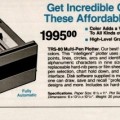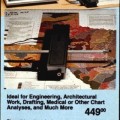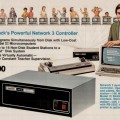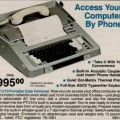The TRS-80 "Model 5"
Radio Shack introduced the TRS-80 Microcomputer System, later known as the Model I, in August 1977. It was the first member of the original line of TRS-80 computers. Radio Shack followed the Model I with the mostly compatible Model III in 1980 and then the Model 4 in April 1983. But other than the transportable Model 4P in November 1983 and the improved Model 4D in 1985, there were no further members of this computer family.
Around the time of the development of the Model 4, Radio Shack engineers did some planning work on a computer that could have followed it. Although not known by the name within Radio Shack, this often rumored computer was usually called the “Model 5” or the “Model 4C” by the public.
By considering all the available bits of information, it is possible to piece together details about the key features of the “Model 5”:
- A 16-bit Z800 processor (Z80 compatible), possibly running as fast as 8 to 10 MHz.
- Up to 512K of memory possible (the Z800 was capable of addressing 16MB).
- Built-in color, probably with a detached monitor, possibly with high-resolution graphics as an option.
- Improved sound, probably using a sound chip such as the Texas Instruments SN76489 (a version of which was later used in Radio Shack’s MS-DOS compatible Model 1000).
- A detached keyboard, probably with extra keys (such as brackets) not on the Model 4 keyboard.
- Floppy disk drives standard, with no cassette tape interface.
- Booting using a special boot ROM, which could then load a Model III ROM as needed. This also would have allowed booting from a hard drive.
- A slot arrangement for adding expansion cards (in particular an internal modem card).
Of course, there is no guarantee that all of those features would have made it into a finished computer, or even that they were all planned at the same time. Several people, including William Schroeder, the president of Logical Systems (authors of Model 4 TRSDOS), have mentioned seeing the computer while in development.
Undoubtedly, there would have been a new version of TRSDOS to take advantage of the extra features. Model 4 TRSDOS was designed to allow for expandability into many of these areas. For example:
- The video supervisory calls (SVC’s) had one register reserved for unspecified reasons. William Schroeder once confirmed that it was reserved for color.
- The sound SVC parameters imply sound capabilities better than those present in the Model 4. (Actually, unused logic in the Model 4 sound board suggests it was originally designed with better sound than the Model 4 shipped with.)
- The extended memory SVC could support up to 4 MB, even though a stock Model 4 was only capable of using 128K.
It’s easy to see how a “Model 5” with color, sound, and a 16-bit processor could have competed with contemporary computers while still providing backwards compatibility with the Model III and Model 4. Perhaps more importantly, it could have provided a clear upgrade path for future TRS-80 computers.
But unfortunately, it was not to be. For a variety of reasons, Radio Shack never took the development of the computer very far. The biggest reason was the many problems Zilog had with the incredibly powerful, but much delayed Z800. Although announced in 1982, Zilog didn’t produce the part until 1987 (as the Z280), far too late to be useful. Other factors, such as a switch in focus to MS-DOS and internal politics within Radio Shack, doomed the project before it could advance very far.
Any development on the project was cancelled by 1984, but rumors about the “Model 5” and “Model 4C” persisted for years after that. In 1985, in response to a question asking about the “Model 4C” by name, a Radio Shack representative officially denied the rumors in the “Ask Tandy” column in 80 Micro, stating:
We have no plans for a color version of the Model 4 or an Apple IIc look-alike.
Several of the “Model 5” features, such as a detachable keyboard, boot ROM, and internal modem card were implemented as part of the TRS-80 Model 4P.














jj says:
Good article. Pretty much matches what I remember except I think slots got discarded early on. Too bad Zilog couldn’t get their act together. A TRS-80 with Z800 would have blown away all the others.
Bill Loguidice says:
Excellent post and sound theory. Considering some of the crippled features found in the much later Color Computer 3, it was probably for the best that a Model 5 never saw the day of light, though having a Model x with standard color would have been pretty cool. I also wonder if the decline of CP/M in the face of PC DOS was another contributing factor in Tandy’s decision not to take the line to a next generation? Certainly they gambled correctly with the 1000 series, though they of course failed to see that through properly ultimately as well.
Jeff Joseph says:
Even without the vaporware Z-280, Tandy/Rad Shack could have extended the Model 4 architecture much farther than that of the 4D — simply by modding the board to accept 256K DRAM chips and extending the OPREG bank-switch register, and upping the Z-80 clock. Built-in high-resolution video and a programmable characterset ROM, and standard 720K 3.5" floppy drives would have not been too hard, either.
Problem is, the product managers of the other Tandy computer product lines had more political clout within the Ft. Worth hierarchy. Such an improved Model 4 would have competed with their own pet projects, stealing sales. Actually, stunting the TRS-80 line only encouraged Model 4 owners to migrate to MessDOS. Such is the problem when a company tries to imitate the General Motors marketing model: a product for every possible consumer niche. Doesn’t work for computers. No wonder Tandy eventually went under, as they deserved to.